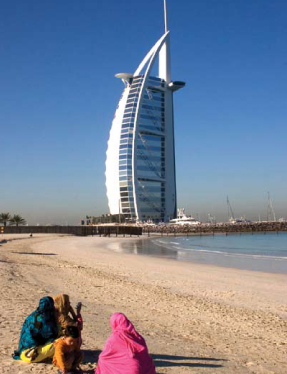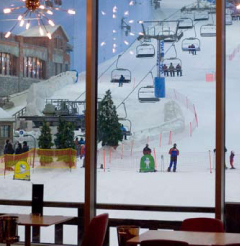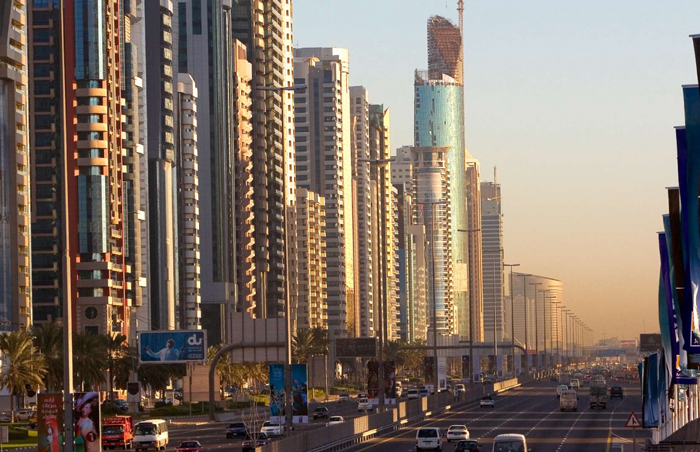“THE EARTH HAS A NEW CENTER,” proclaims a billboard on the road into Dubai. It was 2 a.m. and I’d just flown in from Ethiopia, where I’d been on a magazine assignment. I decided to take advantage of a layover in Dubai for few days to see what all the hype is about. The media are fascinated with this “city of the future,” one of the seven United Arab Emirates on the Arabian Peninsula, and the fastest-growing metropolis on the planet.
The airport was a glitzy shopping mall—the first of many I would encounter—with hotels and restaurants and international travelers crowding the Internet cafes. Late-model taxis with computerized meters and English-speaking drivers lined up outside.
I arrived without a hotel reservation—not ideal—but I got lucky at a hotel information counter in the airport: an apartment in a new building in Bur Dubai, the area I most wanted to see. The rate was just $110 a night as a last-minute booking, much lower, it turns out, than the rates listed online.
This was my first visit to the Arab world, and I was more curious about Arabic and Bedouin culture than about the mega-malls Dubai has become known for. The historic areas of Bur Dubai and Deira straddle Dubai Creek, where the cargo vessels called dhows dock. The narrow streets and souks, my Lonely Planet guide promised, exude authentic charm. I wanted to see this older city as well as the “21st-century phenomenon” of new Dubai, so I decided to cover a lot of ground.
The first day luckily was a Friday, a Muslim holiday. That meant relief on the freeways from the workweek’s traffic jams. The skyline is monstrous, an astonishing sight as it comes into view. Towers of gleaming glass, chrome and granite are packed like shiny sardines along Sheik Zayed road, the main drag running east-west. As recently as the early ‘90s, this was an empty desert road.
Described in a 2006 Vanity Fair article as a “skyline on crack,” the construction spreads in all directions. Skyscrapers sprout up in record time. Everything seems to meld together in a futuristic blend of cutting edge architecture.
 The driving force behind this extraordinary growth is Dubai’s ruler, Sheik Mohammed bin Rashid al Maktoum, who is expanding his late father’s vision of a world business-and-tourism hub. Sheik Mohammed is worth an estimated $27 billion.
The driving force behind this extraordinary growth is Dubai’s ruler, Sheik Mohammed bin Rashid al Maktoum, who is expanding his late father’s vision of a world business-and-tourism hub. Sheik Mohammed is worth an estimated $27 billion.
Tens of thousands of immigrant laborers work eight- to 12-hour shifts round the clock to make this dream a reality. Dubai has been criticized for its treatment of these construction crews, mainly Pakistanis and South Asians, forced to work in extreme heat and often cheated out of wages by layers of agents. After a strike, the government began imposing fines and monitoring work schedules and living conditions.
Dubai’s “race for the top” includes the Burj Dubai, designed to be the world’s tallest building with an estimated 160 stories when it’s completed in 2008. Every residential unit was sold before the second story went up.
Viewed over the sea of cranes, earthmovers and scaffolding, the dusty landscape looks almost like a movie set with a computer-generated backdrop that couldn’t possibly be real. I kept wondering, what’s the hurry? The answer, of course, is money.
National Geographic reported in January that Dubai “has created one of the most dynamic business environments in the world,” with “no corporate or income taxes and a top-notch banking system.” —which could be the reason Halliburton recently made the decision to relocate its headquarters there. The population, at 1.4 million people today and up from 183,200 in 1975, is projected to reach 2 million in three years. Only 10 percent of residents are Emiratis; the rest are expats. Wealthy company executives and skilled labor from all over the world enjoy tax-free living, often with cushy packages that include a beach villa or penthouse, a Porsche or Mercedes and free health care.
An estimated 5 million visitors descend on Dubai each year to shop, sunbathe, enjoy sumptuous restaurant fare and shop some more. The government hopes to grow that number to 15 million by 2010.
The number of shopping venues in Dubai is mind-boggling. The Mall of the Emirates is just one of dozens of lavish creations. It boasts 6.5 million square feet of luxury shops and restaurants, built around a 260-foot indoor ski slope.
The mall is filled with glittering granite floors, top designer shops, and posh boutiques. In the Après Ski restaurant, you can watch as skiers schuss down fake slopes and kids toss faux snowballs. The flat-screen digital fireplace makes the artificial atmosphere complete.
Next stop is Jumeirah Beach, home of the Burj Al Arab Hotel. Built in the shape of a billowing sail, the hotel has become an icon of the modern Dubai coastline. I was hoping to see the lobby, said to be lavish to the point of gaudiness. But it’s not an establishment you can just wander into. With rooms starting at around $1,500 a night and all the opulence of the world’s only seven-star hotel, I didn’t get past the guard kiosk. I later learned that for about $50 you can make a reservation to have a cocktail at the hotel’s Skyview Bar. From the beach you get a good view of the exterior, which sits on a man-made island built on pillars 900 feet offshore.
Also man-made, a few miles beyond, is the Palm Jumeirah, a palm-tree-shaped island where 17 “fronds” jutting into the ocean contain 4,000 villas. Two other “palms” are under construction, one with luxury housing for 70,000 residents and still more high-end hotels. The third is expected to be larger than the city of Paris. Also in the works is an archipelago of 300 man-made islands forming a map of the world. Critics say these ambitious projects are hazardous to the Persian Gulf’s ecosystem.
When I’d seen enough of modern Dubai, I followed Lonely Planet’s advice and wandered the old settlement areas. In Bur Dubai, the creek buzzed with activity: souks, vendors, open-air cafes.
You can hop on an abra (water taxi), hand the driver a one-dirham coin (about 27 cents) and cruise across to the Deira side. You might sit next to a businessman speaking Arabic on his cell phone, wearing traditional garb and a gutra headcloth. Or watch a Muslim mother pass sandwiches around to her kids. The atmosphere is friendly and relaxed.
I glimpsed what the early days must have been like, with wooden dhows docked along the Deira harbor, workers loading and unloading wares from around the world. Just off the main waterfront, the streets become narrower. One souk leads to another—from spices to clothing to gold. The gold-vending souk is rows of jewelry shops, with displays of elaborate “wedding necklaces,” bracelets and chains. Wander farther into the winding alleyways and the atmosphere becomes less touristy.
Several mosques with beautiful minarets and multiple domes are lit up against the evening sky. The call to prayer echoes from loudspeakers; men make their way through the old neighborhoods and kick off their shoes at the mosque entrance.
One of the oldest buildings in Bur Dubai is the Al Fahidi Fort, once the seat of government. It now houses the Dubai Museum, which has photographs of the early free-trade port. Nearby is the Bastakia Quarter, with restored courtyard houses and cafes, galleries and wind towers, an early form of air-conditioning that funneled cool air into the house. Wealthy merchants and traders built these homes in the early 20th century.
The Bur Dubai textile market has shop after busy shop selling silks and other fabrics from around the world. Intricate silver knives, jewelry and water pipes line other stalls. Cheap local restaurants serving Indian, Chinese and Lebanese food (or sometimes all three) are tucked in between.
The last afternoon of my stay I used my hotel to arrange a desert safari—$80 including pickup and drop-off. Skidding around in a four-wheel-drive jeep through the bright orange sand dunes turned out to be a blast. The outing included a sunset camel ride and a barbecue dinner, Bedouin style, complete with belly dancer. Touristy as it was, I dined under the stars with two sisters from Belgium and had a lovely time.
On a Dubai map I could see the places I wouldn’t have time to see, as well as still-unfinished coming attractions. Much of the map is labeled (u/c) for “under construction.” Dubailand, for example, will be a 3-billion-square-foot fantasy theme park and entertainment complex the size of two San Franciscos. The $20 billion vision of Sheik Mohammed, it’s expected to attract 200,000 visitors daily.
Other spots that will have to wait for a future visit: Internet City, Media City, Knowledge Village, and the Camel Race course. Short excursions to the surrounding areas of Hatta in the mountains and the cities of Sharjah and Fujairah also sound interesting. Next time I’m on the 12-hour flight from New York, I’ll plan a longer stay.
Image 1: Burj Al Arab Hotel on Jumeirah Beach, was built to resemble the sail of a dhow.
Image 2: Indoor skiing in Dubai


